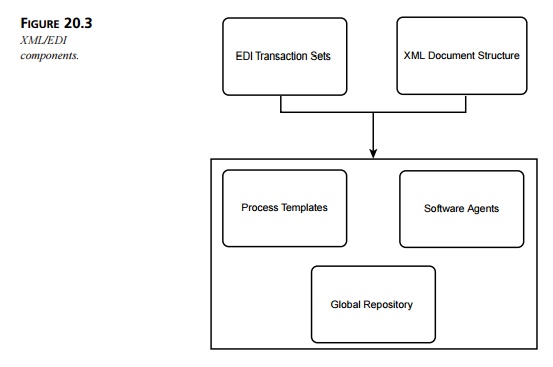Chapter: XML and Web Services : Applied XML : Implementing XML in E-Business
XML/EDI
XML/EDI
One of the first steps in attempting to get closer to an XML-based means
for e-business interchange is the XML/EDI effort. This effort, in effect, is a
combination of the best practices and technologies learned from EDI with the
benefits that XML provides.
A lot of time and effort was put into making traditional EDI a success.
Consequently, a lot of best practices and business process know-how was
inserted into EDI specifications, software, and implementations. The desire to
uproot these systems and replace them with completely redesigned ones makes
some implementers hesitate, at best. However, the set-backs and challenges of
EDI implementation have also thrown a wrench into many EDI rollouts. Therefore,
a halfway solution must be found that can improve EDI with new technology while
not throwing it completely out.
It is in this spirit that XML/EDI was created. The vision for XML/EDI is
to allow orga-nizations to deploy a system that allows each trading partner to
exchange e-business information using XML and Internet technologies, leveraging
not just the old structures of EDI data but also process control templates and
business rules as well. XML/EDI consists of five major components:
XML base specification
EDI transaction sets
Templates for process logic
A global repository and reference
dictionary
Agents and implementation methods
These five components are combined to provide an e-business system that
delivers e-business data as well as processes logic. By doing so, XML/EDI hopes
to address the following list of requirements and solutions to the typical
“ailments” of EDI:
Reduce the cost of doing business
Reduce the cost of entry into
e-business
Provide low-cost, easily
implemented tools
Improve data integration and
accessibility
Maintain appropriate security and
control
Utilize technology that can be
extended and maintained with little adverse business impact
Integrate with today’s systems
Utilize open standards
Provide a successor to
X12/EDIFACT and interoperability for XML syntaxes
Be globally deployable and
maintainable
It doesn’t take much effort to simply encode EDI transaction sets into
XML. Therefore, the real work and benefit is in encapsulating the various
business processes, logic, and value-add that EDI provides beyond simple
document encodings. XML/EDI has added the concepts of using process templates,
the XML/EDI repository, and software agents as means to providing these
benefits. Figure 20.3 illustrates the interaction of the five major components
of XML/EDI. As you can see, XML and EDI are separate technologies, whereas the
others are contained within the auspices of XML/EDI.

Process templates are built using XML and express work requirements
throughout the system. They describe and control business context and process
definitions that enable trading partners and users of the system to locate the
correct components they need. As has been defined earlier, the XML/EDI
repository provides a mechanism for users to define and look up meanings for
the definitions of various e-business entities. As a result, described
interfaces can be automatically searched and identified. The repository system
provides a semantic foundation for e-business transactions while simultaneously
enabling software agents to identify and reference business document entries.
In this regard, software agents serve several key functions and
requirements. They are applied to process templates and interpret the results
in order to determine work to be performed, and they interact with entries and
definitions in the repository to apply and integrate the appropriate data per
each business task. They accomplish this by searching the business repository
and attaching the right template for processing.
Related Topics